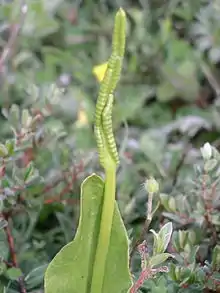Ophioglossum
Ophioglossum, the adder's-tongue ferns, is a genus of about 50 species of ferns in the family Ophioglossaceae. The name Ophioglossum comes from the Greek, and means "snake-tongue".[2] The genus has the largest number of chromosomes in the known plant kingdom, but contrary to popular belief does not have the largest number of chromosomes out of all known organisms, falling short to the protist Oxytricha trifallax.
| Ophioglossum | |
|---|---|
 | |
| Ophioglossum vulgatum | |
| Scientific classification | |
| Kingdom: | Plantae |
| Clade: | Tracheophytes |
| Class: | Polypodiopsida |
| Order: | Ophioglossales |
| Family: | Ophioglossaceae |
| Subfamily: | Ophioglossoideae |
| Genus: | Ophioglossum L.[1] |
| Species | |
|
See text | |
| Synonyms[1] | |
| |
Their cosmopolitan distribution is mainly in tropical and subtropical habitats.[2]
Description
Adders-tongues are so-called because the spore-bearing stalk is thought to resemble a snake's tongue. Each plant typically sends up a small, undivided leaf blade with netted venation, and the spore stalk forks from the leaf stalk, terminating in sporangia which are partially concealed within a structure with slit sides.[2]
When the leaf blade is present, there is not always a spore stalk present, and the plants do not always send up a leaf, sometimes going for a year to a period of years living only under the soil, nourished by association with soil fungi.
The plant grows from a central, budding, fleshy structure with fleshy, radiating roots.
Taxonomy
Ophioglossum has a high chromosome count in comparison to other species, with 120 or up to 720 chromosomes possible in intervals of 120 due to polyploidy (multiple possible copies of chromosomes). It has almost 1260 number of chromosomes in the meiocyte (gamete mother cell) which undergo meiosis, the reduction division to form the gamete with only one set of chromosome getting incorporated into each gamete. [3]
Species
As of April 2020, Plants of the World Online recognised the following species:[1]
- Ophioglossum azoricum C.Presl
- Ophioglossum bergianum Schltdl.
- Ophioglossum californicum Prantl
- Ophioglossum caroticaule J.E.Burrows
- Ophioglossum convexum J.E.Burrows
- Ophioglossum coriaceum A.Cunn.
- Ophioglossum costatum R.Br.
- Ophioglossum crotalophoroides Walter
- Ophioglossum eliminatum S.Khandelwal & H.K.Goswami
- Ophioglossum ellipticum Hook. & Grev.
- Ophioglossum engelmannii Prantl
- Ophioglossum falcatum (Presl) Fowler
- Ophioglossum fernandezianum C.Chr.
- Ophioglossum × giovanninii Peruzzi, Pierini, Magrini, Marchetti & Viane
- Ophioglossum gomezianum Welw.
- Ophioglossum gracillimum Welw.
- Ophioglossum gramineum Willd.
- Ophioglossum gujaratense S.M.Patil, R.N.Kachh., R.S.Patel & K.S.Rajput
- Ophioglossum harrisii Underw.
- Ophioglossum intermedium Hook.
- Ophioglossum kawamurae Tagawa
- Ophioglossum lancifolium C.Presl
- Ophioglossum latifolium (Prantl) J.E.Burrows
- Ophioglossum lineare Schltr. & Brause
- Ophioglossum louisii Taton
- Ophioglossum lusitanicum L.
- Ophioglossum lusoafricanum Welw.
- Ophioglossum malgassicum (C.Chr.) Christenh.
- Ophioglossum melipillense Gay
- Ophioglossum nudicaule L.f.
- Ophioglossum oblongum H.G.Zhou & H.Li
- Ophioglossum oleosum S.Khandelwal
- Ophioglossum opacum R.Br.
- Ophioglossum palmatum L.
- Ophioglossum parvifolium Grev. & Hook.
- Ophioglossum parvum M.Nishida & S.Kurita
- Ophioglossum pendulum L.
- Ophioglossum petiolatum Hook.
- Ophioglossum × pierinii Peruzzi, Magrini, Marchetti & Viane
- Ophioglossum polyphyllum A.Braun ex Seub.
- Ophioglossum × pseudoazoricum Peruzzi, Pierini, Magrini, Marchetti & Viane
- Ophioglossum pusillum Raf.
- Ophioglossum rabellum Welw.
- Ophioglossum reticulatum L.
- Ophioglossum richardsiae J.E.Burrows
- Ophioglossum sandieae J.E.Burrows
- Ophioglossum scariosum R.T.Clausen
- Ophioglossum simplex Ridley
- Ophioglossum thermale Kom.
- Ophioglossum thomasii R.T.Clausen
- Ophioglossum vulgatum L.
- Ophioglossum yongrenense Ching ex Z.R.He & W.M.Chu
References
- "Ophioglossum". Plants of the World Online. Royal Botanic Gardens, Kew. Retrieved 22 April 2020.
- eFloras: Ophioglossum accessed 14 February 2014.
- Lukhtanov, Vladimir (2015-07-10). "The blue butterfly Polyommatus (Plebicula) atlanticus (Lepidoptera, Lycaenidae) holds the record of the highest number of chromosomes in the non-polyploid eukaryotic organisms". Comparative Cytogenetics. 9 (4): 683–690. doi:10.3897/compcytogen.v9i4.5760. PMC 4698580. PMID 26753083.